Majesty, lots of gold, Buddhas and cats. All this we can see in the temples of Bangkok, we take you to see them.
Bangkok is one of the most popular tourist destinations in Asia, and for good reason. The city is home to some of the most impressive temples in the region. Here are four of the must-see temples in Bangkok, so you won’t miss them during your trip to the city.
While we were in Bangkok we were able to visit several Buddhist temples, the options were many and the time was short, so we had to choose. Here we give you an idea of what you can see on your next trip to Thailand.
During the two days we were in Bangkok, we could visit these four places that we present in this article. Although as you can see in the first photo, there are mini temples scattered throughout the city, what happens is that people usually put them in their businesses to attract good things.
Taking the bus in Bangkok
To transport us from our hotel we took the urban bus, thanks to Google maps we could see which line was the most convenient for us and with the GPS, we could see when we were getting closer to where we wanted. You pay in a peculiar way: you get on and sit where possible, then a person will approach you with a small metal box that they shake to imply that you are to pay, after you pay them, they give you the ticket and that’s it.
Attention: the buses have different prices depending on whether they have air conditioning or not, don’t be surprised if the girl asks you for more money or gives you change when you don’t expect it.
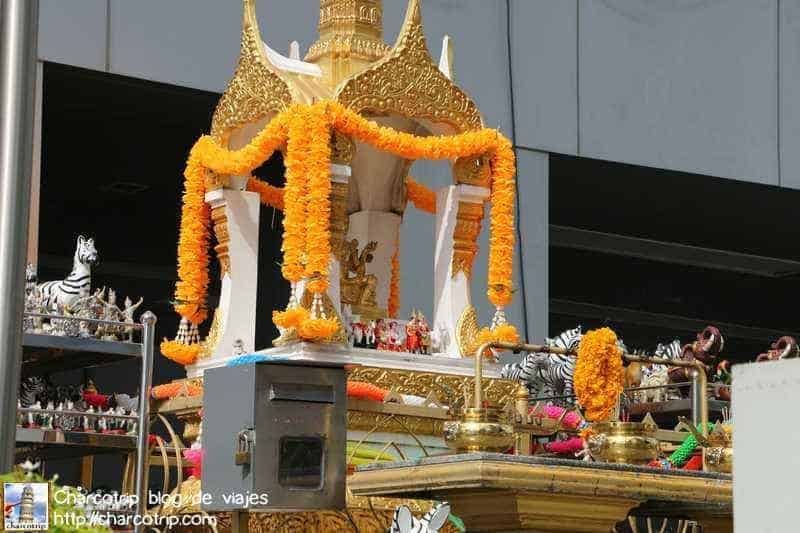
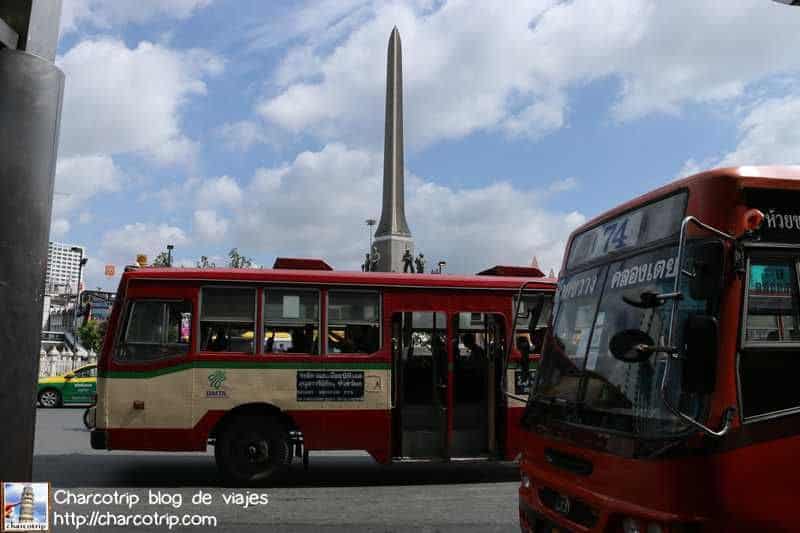


Wat Phra Kaew (or Emerald Buddha) Temple
It is the most important Buddhist temple in Thailand, it is located in the historic center of Bangkok within the area of the Grand Palace of Bangkok. For cultural reasons, long pants are required to enter the temple.
Information to visit the Wat Phra Kaew Temple
How much is it?
500 bahts
Which are the schedules?
From 8:30 AM to 3:30 PM
Can you take photos?
Yes, except in the building where the Emerald Buddha is located.
Get your flight to Bangkok at the best price
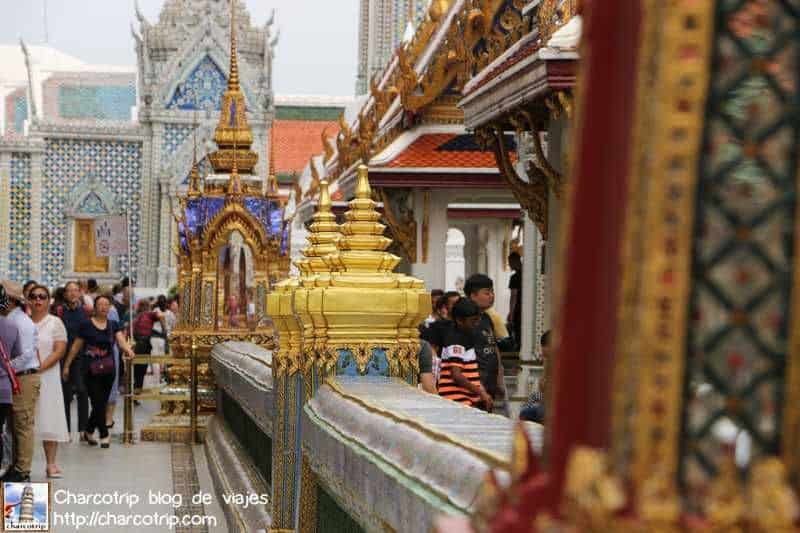
A bit of history about Wat Phra Kaew
The construction took place when King Rama I moved the capital to Bangkok in 1785. Unlike other temples, there are no dwellings for the monks here. In the central ubosoth is the emerald buddha (photos cannot be taken) and although it is a relatively small statue it is the main religious icon of the Thai people. Legend has it that it was created in India, and it is said that Rama I captured it (to say the least) in Ventian (Laos) so that it ended up in Bangkok when it was named capital.

How is a visit to Wat Phra Kaew?
From the entrance we realized that it was, in addition to the most important temple in Thailand, one of the most visited. We didn’t arrive first thing in the morning, so we had to walk as good as we could avoiding all the other visitors, oh well. Upon entering we see some huge statues of the “guardians” or giant demons (also called Yakshas) it is like when we see the lions at the entrance of the temples in other countries, they were not very graceful but very curious. The one in the photo is Chakkrawat.
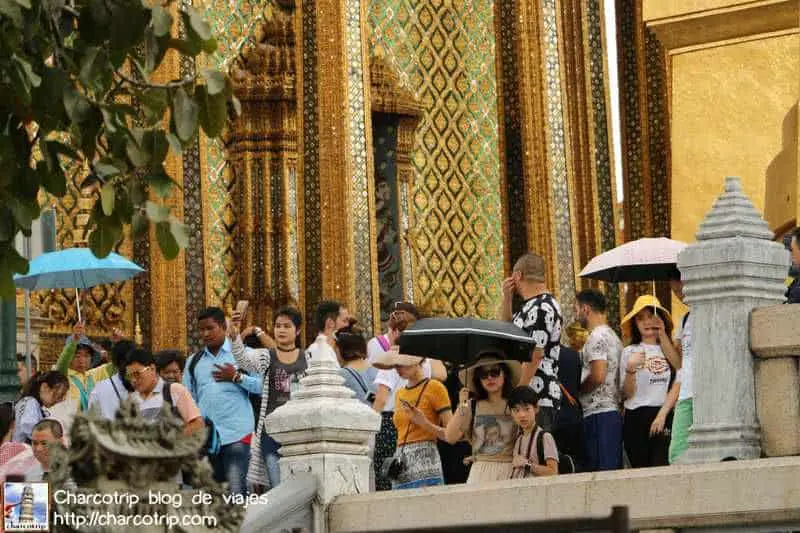
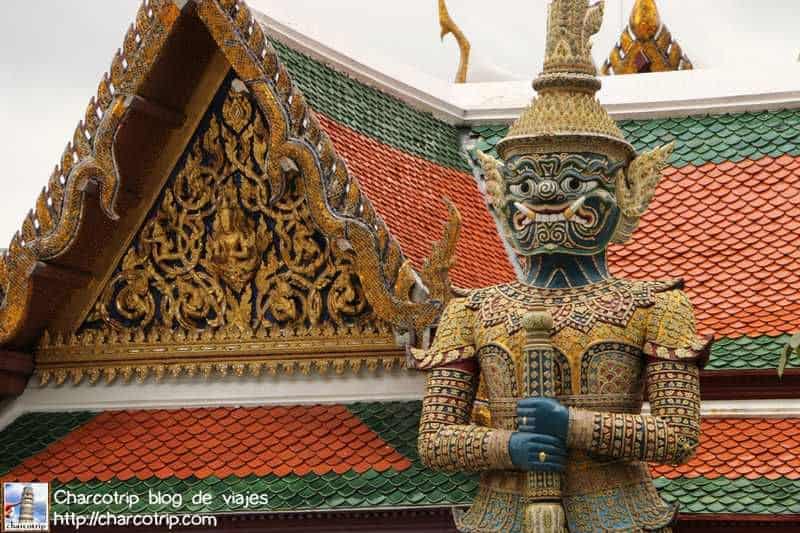


There were times when it rained, but it passed quickly, that’s the good thing about Thailand: despite being the rainy season, it passes quickly. Once the water stopped, we all resumed the visit. Some continued to do so even in the rain and opened their umbrellas. The truth is that the place is literally very bright since there is gold everywhere, so everyone was looking for the best place to take a photo. Even Vincent had to take a photo of a group of Italian tourists, after doing them a favor we asked them if they would take a photo of us too.
In various parts of the enclosure we saw these statues with half-human half-animal bodies, as well as statues of Garuda, which is a mystical bird considered a minor god in Hinduism and Buddhism.

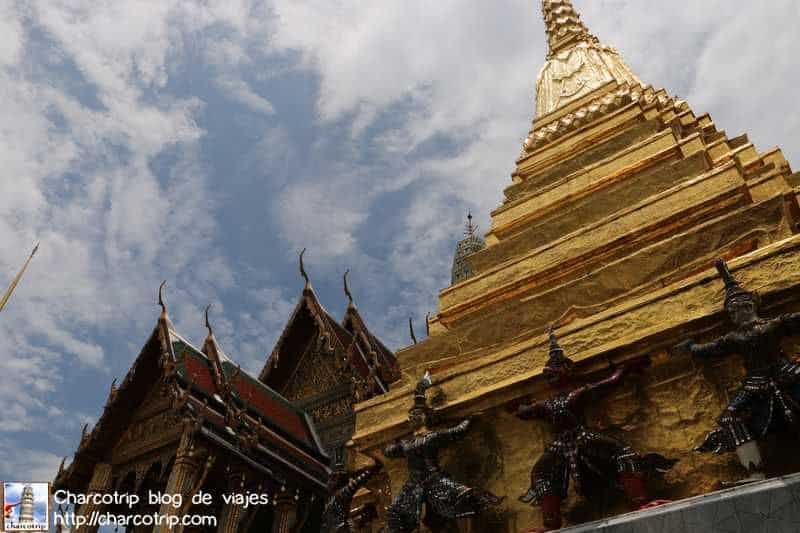
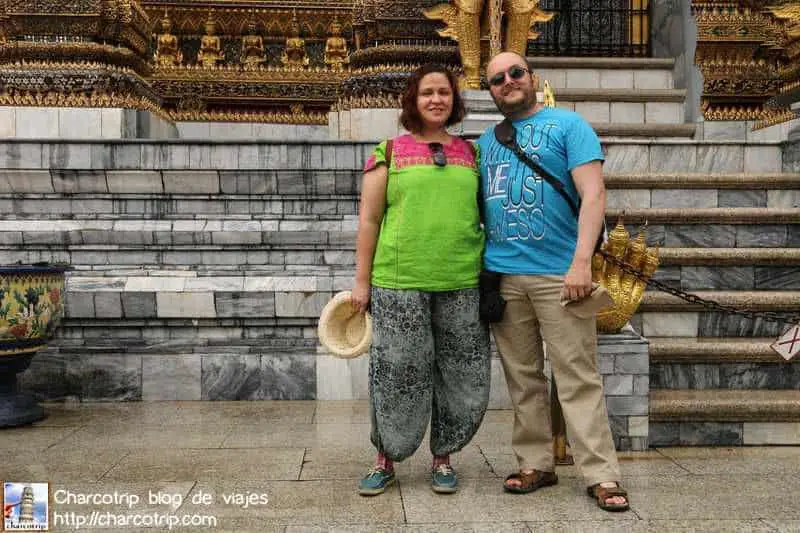
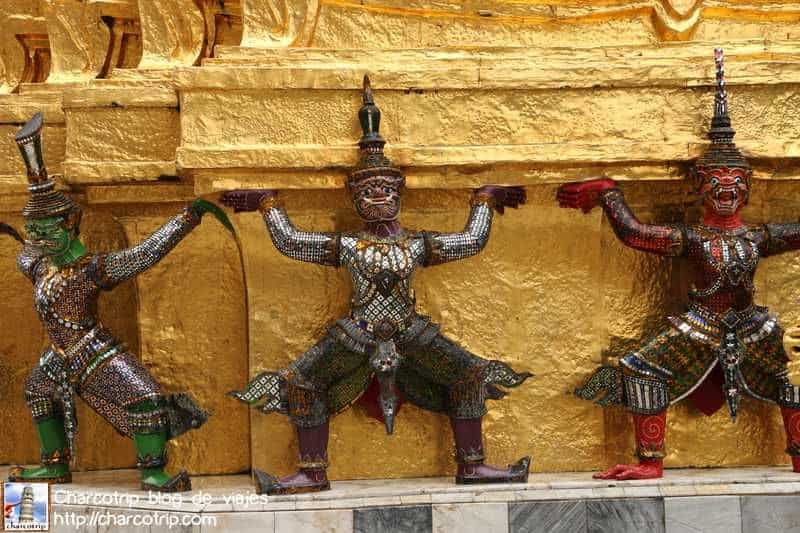

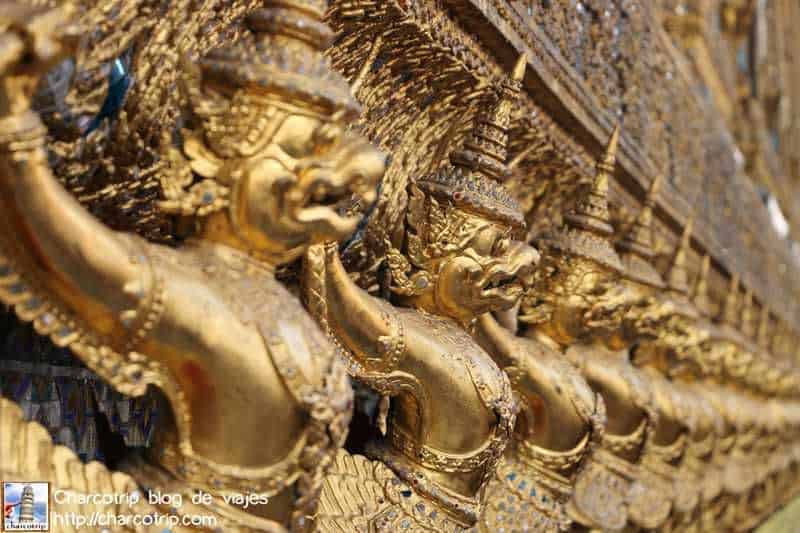

Emerald Buddha
When we entered the main building where the Emerald Buddha is located, we had to take off our shoes. This was a bit of a problem as the floor was wet and not very pleasant, but oh well, it was time to do it. You can’t take a picture inside the building, but I cheated slightly and from the outside I used the mega zoom of my camera to take the silhouette of the Buddha.
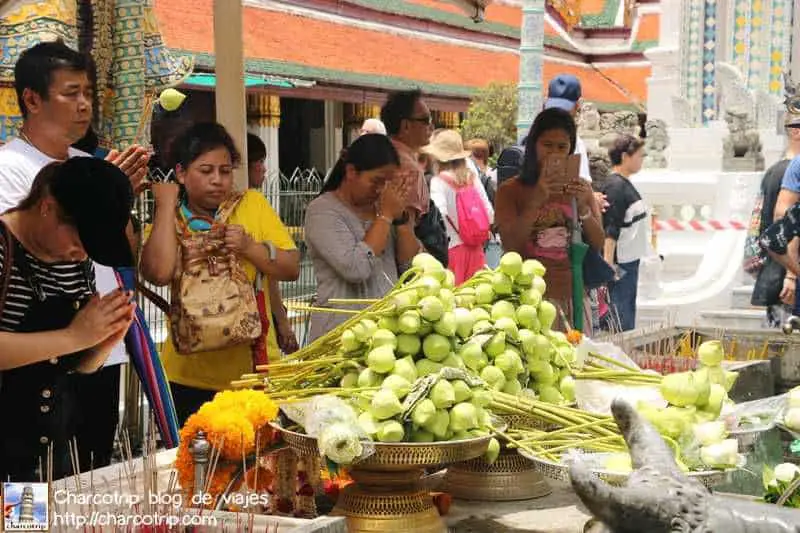


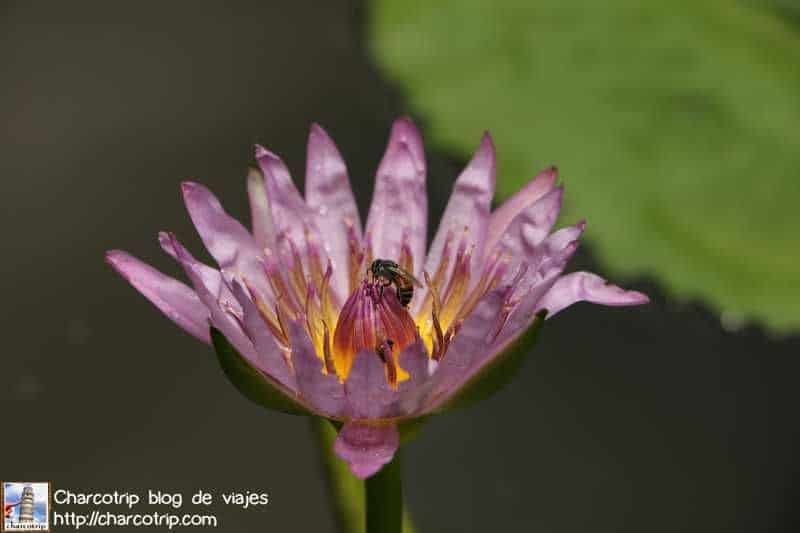
Leaving the enclosure, you can see the “human guards” who are there to guard the royal family. And as we left we found some very nice buildings which were difficult to take a picture of because everyone wanted to take a selfie. In the end, I did it.

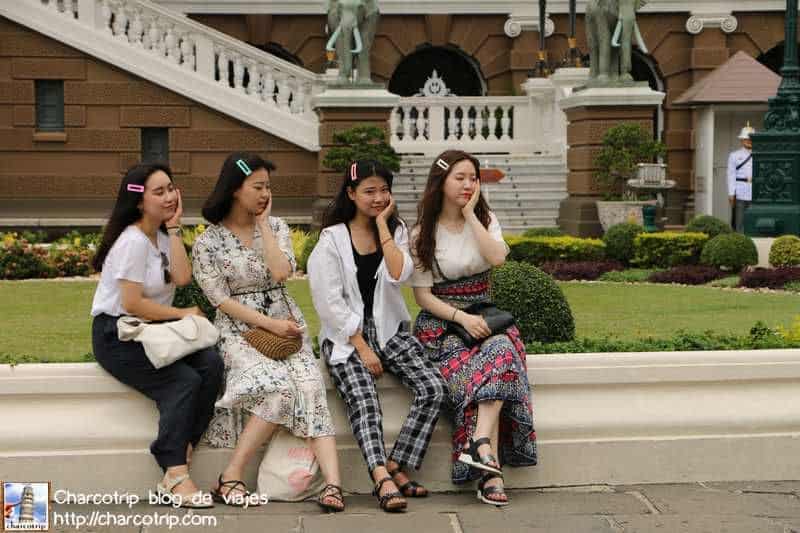

Enjoying Pad Thai
We spent quite some time visiting, so long that we were already hungry, and before going to the next temple we stopped at a restaurant that served Pad Thai. It was quite touristy, but it was good and cheap.

Wat Pho
It is also known as the Temple of the Reclining Buddha, and is located to the south of Wat Phra Kaew (so you can visit both on the same day without any problem). Furthermore, it was built in the 17th century, making it one of the oldest in Bangkok.
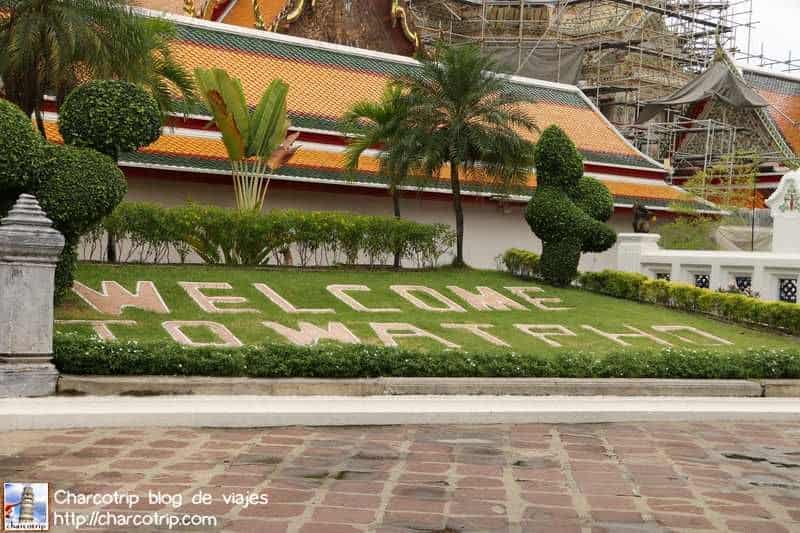
Information to visit the Wat Pho Temple
How much is it?
100 baht (admission includes a bottle of water)
Which are the schedules?
From 8:00 AM to 5:00 PM
Can you take photos?
Yes.

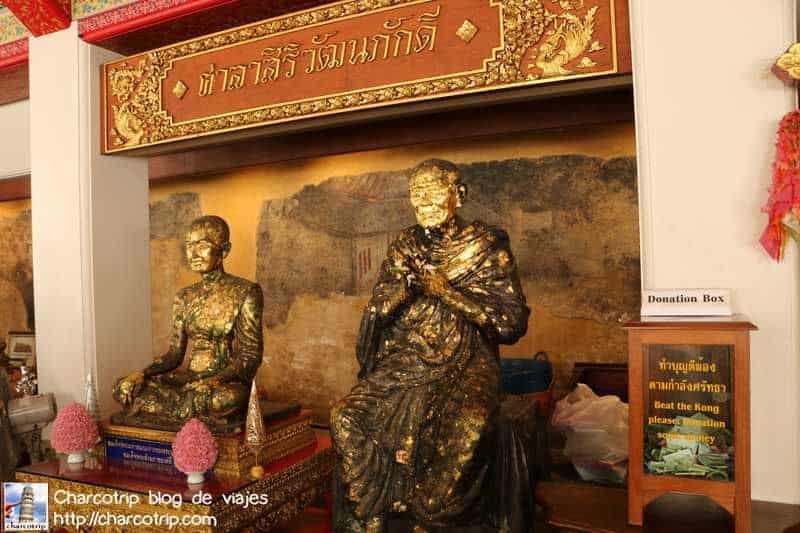
How is a visit to Wat Pho?
Reclining Buddha
The building with the huge Reclining Buddha was built by Rama III in 1832. The sculpture represents the Buddha when he enters Nirvana and ends the cycle of reincarnations. Its dimensions are 15 m high and 46 m long. Upon entering, we took off our shoes and there were plastic bags available, so we could take them with us. When you get to the feet you can see that they are quite flat and are 3 m high and 4.5 m wide and have mother-of-pearl.
On the back of the Buddha you can see 108 bronze containers in which the faithful deposit coins, for good fortune and to maintain the temple. They are 108 since they represent the 108 feelings of the Buddha.
Taking photos of the huge sculpture is already difficult at certain heights, it is even more so since it is where you can better appreciate the pose. This is another pretty popular place in Bangkok, and it shows.

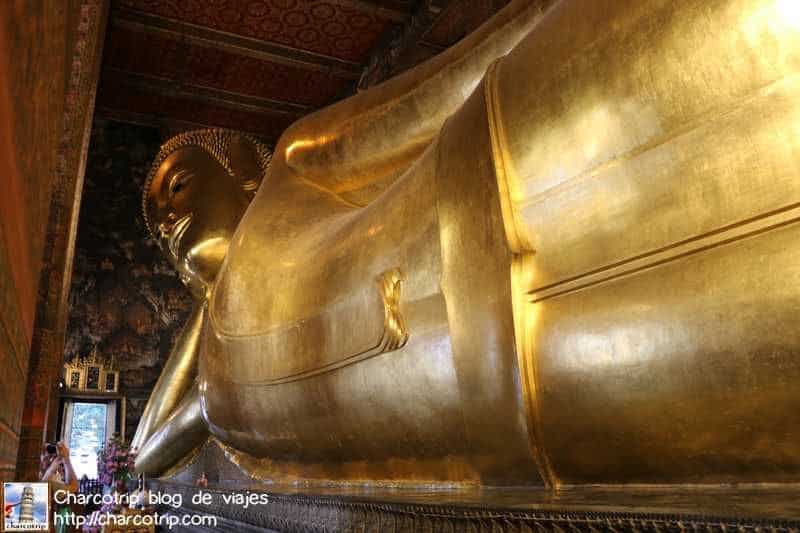

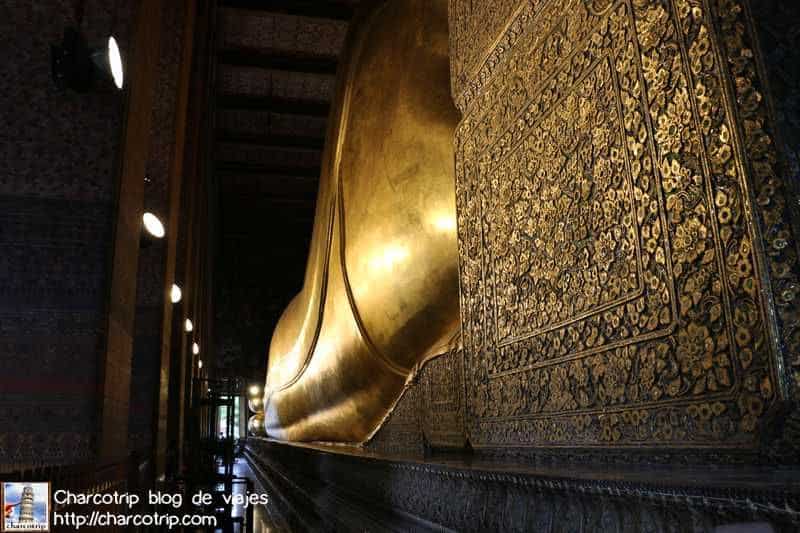

More to see in Wat Pho
And while most people seem to be content to see the huge reclining Buddha and walk away, we walk through the gate to visit the rest of the compound. I don’t know if they do this because they are rushing because they go in a group and the visit is only to the Buddha, or simply because they don’t realize that there is more to see in Wat Pho. I don’t know why, but as our visit continued, the crowds that entered Wat Pho to see the Buddha practically disappeared.
In addition to the Chedi, golden Buddhas, stone statues that made some poses that we found curious and Vincent tried to imitate, we found many cats. They looked so well cared for that we think they were temple pets. Another famous thing at Wat Pho, which we didn’t try, is the Thai massages. Apparently, the temple massage school has an excellent reputation.



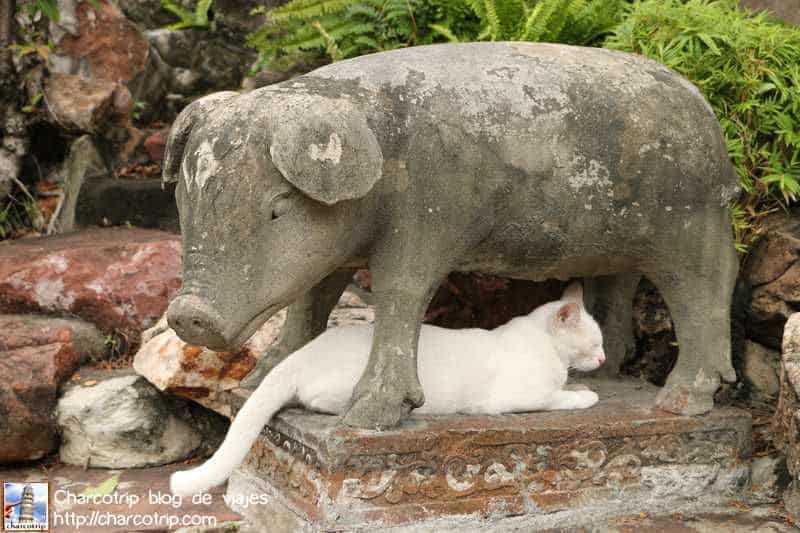

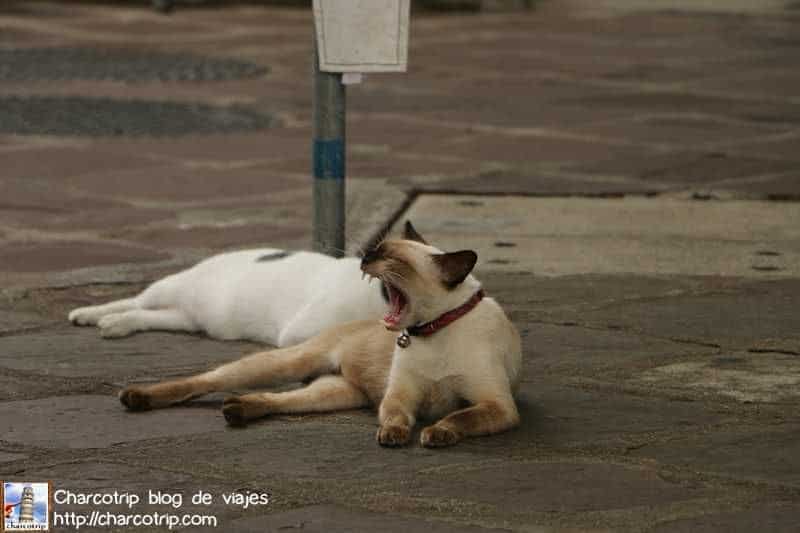
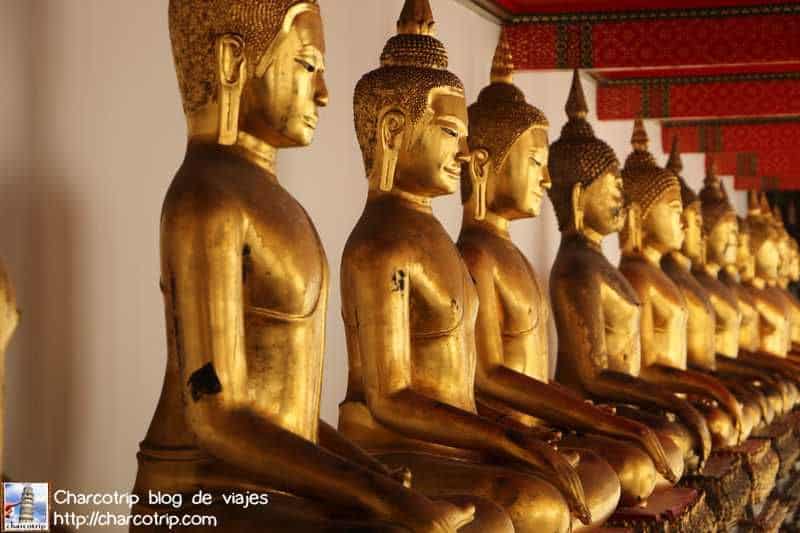
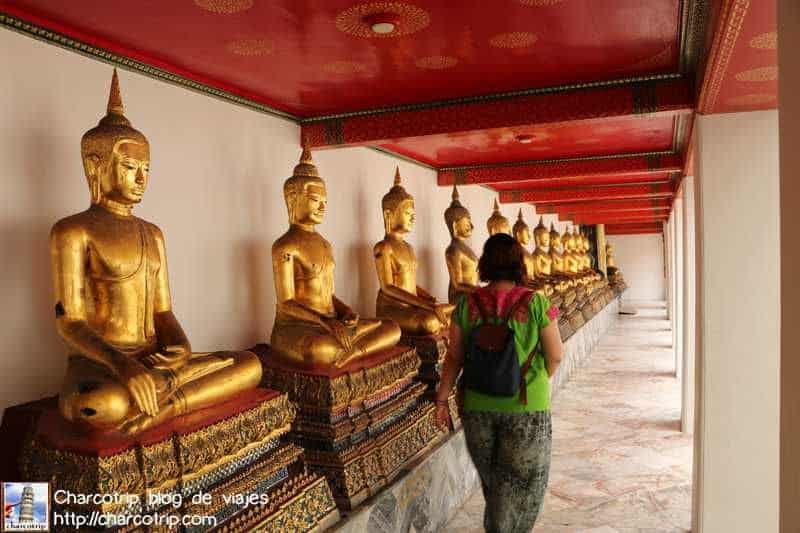

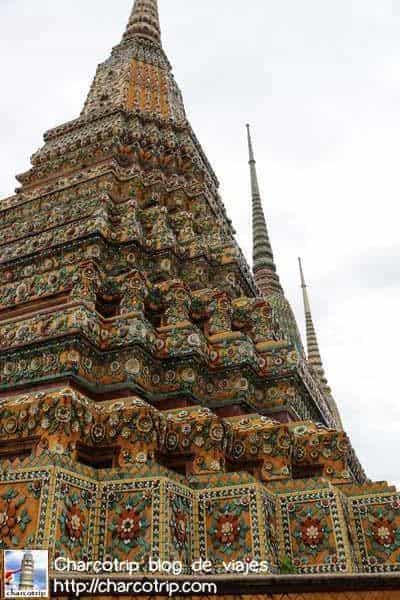
Rain can come at any moment
During our stay at Wat Pho we had a downpour that, no matter how many umbrellas we brought, we would have gotten wet. Luckily, we had a roof within reach. And as almost always happens: the rain passed in the blink of an eye.
And that day we could only see two temples, without hurry. The next morning we went to the same place to see more. Of course, again by urban bus and opening your eyes to the colors of the streets.
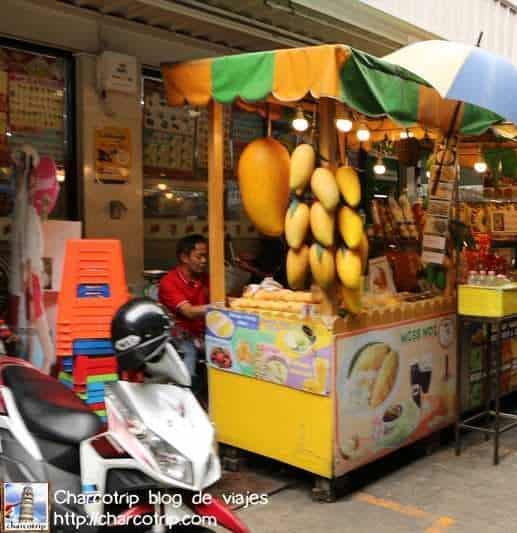
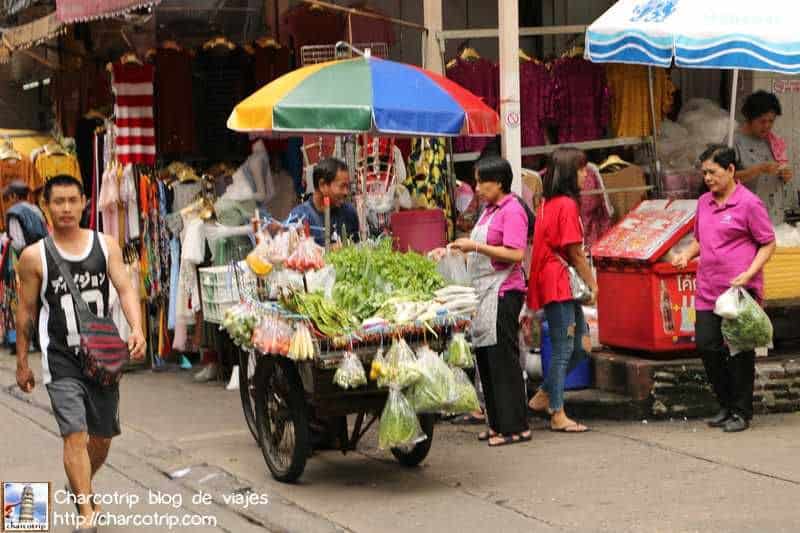
Wat Arun
It’s the temple that you see, just across the Chao Phraya River from the Temple of the Emerald Buddha.
Information to visit the Wat Arun Temple
How much is it?
50 baht + ferry fare
Which are the schedules?
From 8:00 AM to 5:30 PM
Can you take photos?
Yes.
To get to Wat Arun from Wat Pho or Wat Phra Kaew you have to take a ferry that quickly leaves you on the other side of the river.
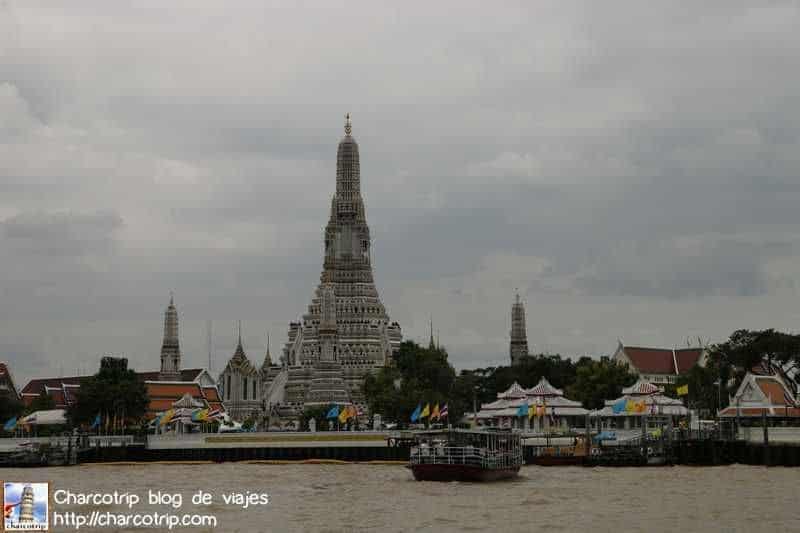
Some history about the temple Wat Arun
It was built when Ayutthaya was still the capital of Thailand, and its original name was Wat Makok (Olive Temple). It changed its name several times until King Rama IV gave it the name we know today.

Our visit to Wat Arun
To get to where you take the ferry, you have to go through several souvenir shops (where on the way back we bought several things). The price is 4 baht. Crossing is quite fast, so if you want to take photos you have to be very alert.
First thing we see upon arrival was the Ordination Hall with Buddhas and guardians. Besides cats. This part can be visited without paying but of course, if one is already there, it is better to visit everything. In addition, the price to enter Wat Arun is not very high compared to neighboring temples.
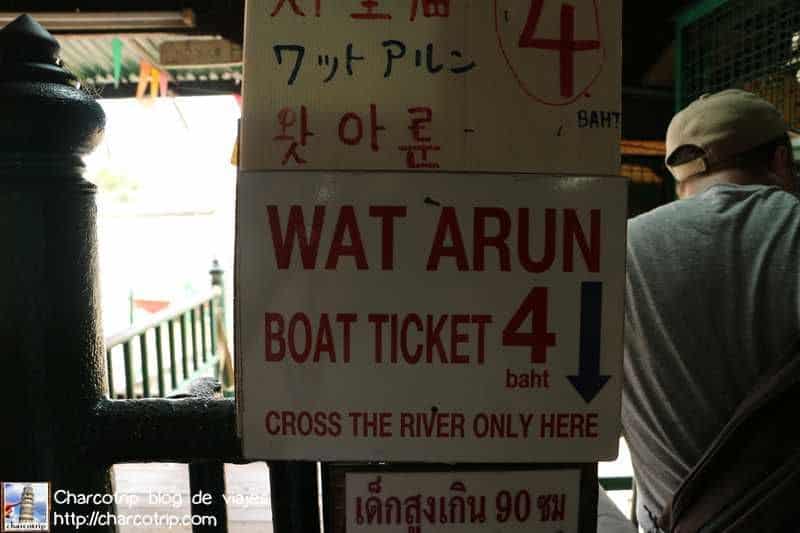



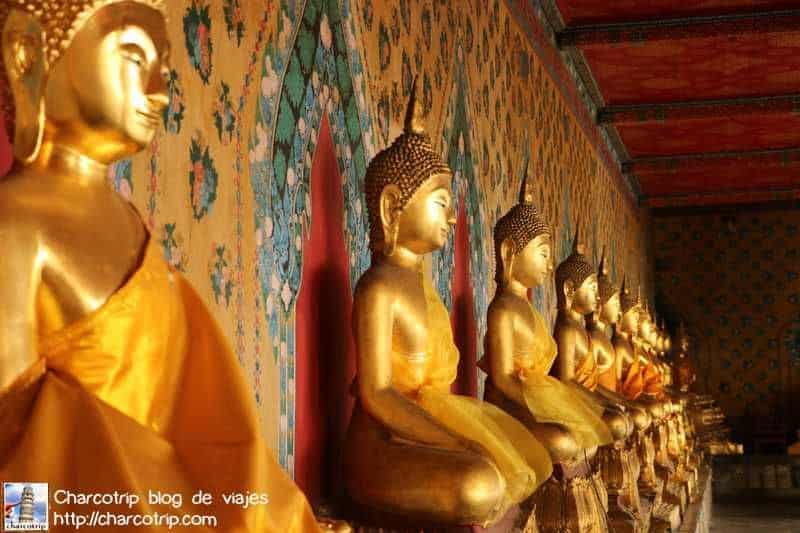
Before paying the ticket, you can see people who rent or sell rags that can be used as a skirt. What happens is that they did not allow to enter the area if the legs were very bare (or the shoulders). The staff at the entrance were quite strict about it. At the entrance you can also see the other way of showing disrespect to Buddha, which is: using Buddha as a banal decoration, and of course at that moment I realized that using it as decoration in a bar or in a house could be seen by them as disrespect towards the symbol. What things!
The enclosure is dominated by a huge tower (or prang) 77 meters high. It is in Khmer style (the style of Angkor Wat). To climb the tower, you have to take some steep stairs which lead to two terraces. It was a bit hard to climb, but the view is not bad, although in certain areas it is a bit tricky to climb as people stop (and even sit) in certain parts and the space on the stairs was minimal.
I have to admit that in this temple I missed the gold, it is a change compared to what I had already seen up to that moment. I’m not saying it was ugly, and I didn’t like it. It just felt very discolored. I think the fact that the sky was whitish also didn’t help.
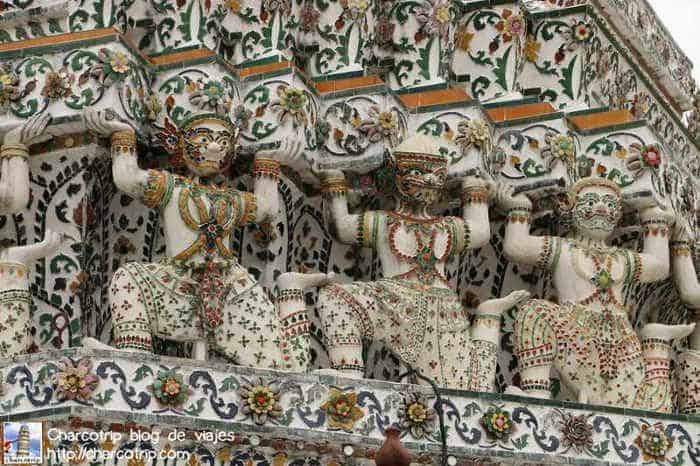
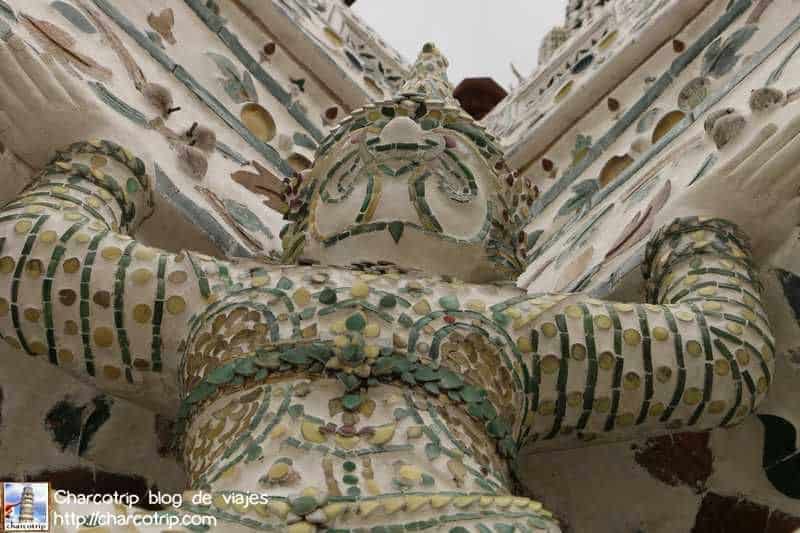

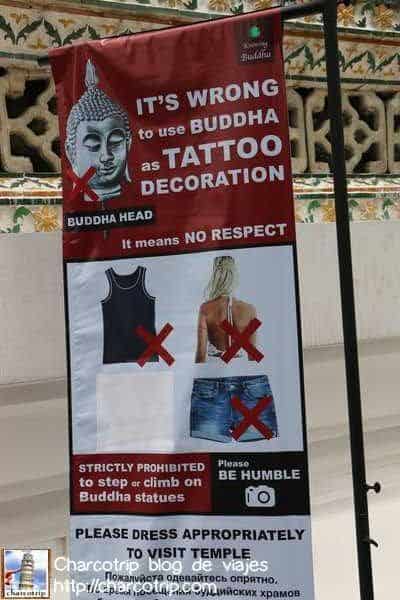

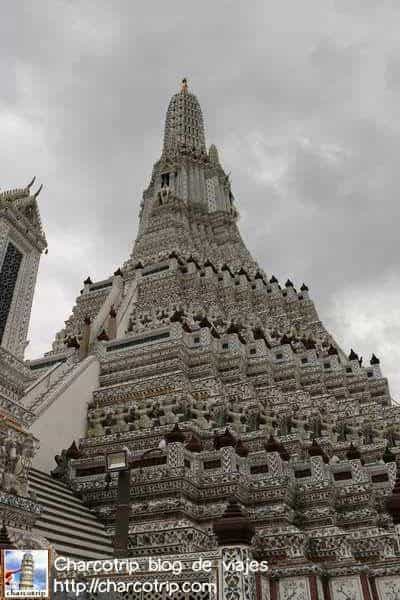
Wat Suthah (or Temple of the Swing)
Information to visit Wat Suthat Temple
How much is it?
100 bahts
Which are the schedules?
From 8:30 AM to 9:00 PM
Can you take photos?
Yes.
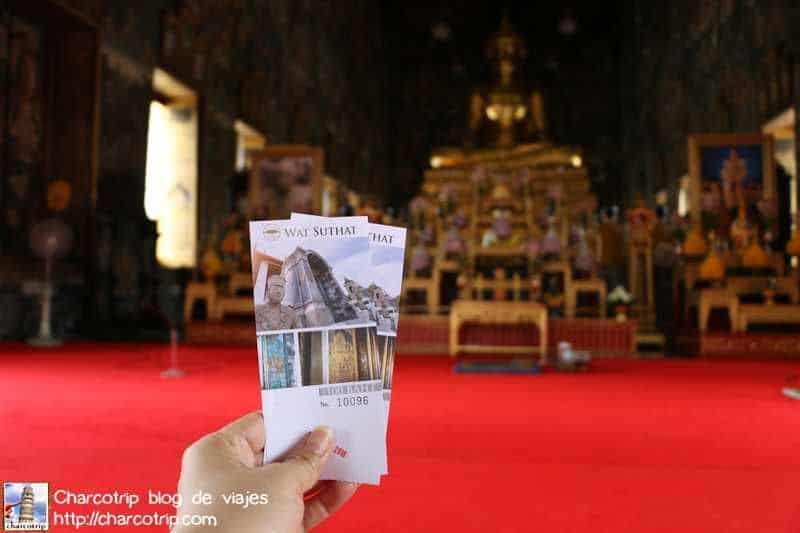
Some history about Wat Suthat Temple
Wat Suthat is known for the huge red swing at the entrance of 21.15 meters high. Its construction was ordered by Rama I, although it was completed until King Rama II was there. This curious swing dates from 1784 and in 2004 it was replaced with one made of gilded teak.
The swing was used for religious rites until it was discontinued in 1932 as dangerous. The rite consisted of swinging on the swing, to celebrate the arrival of the gods, and trying to maintain balance. At the same time, try to grab a bag of silver coins at the top and because of this, there were even deaths.

Our visit to Wat Suthat
In fact, our visit was the other way around as we arrived from the back, so the swing was the last thing we saw. In this temple we could really breathe tranquility, there were much fewer visitors than in the previous three. Of course, what was not missing were the cats 😀


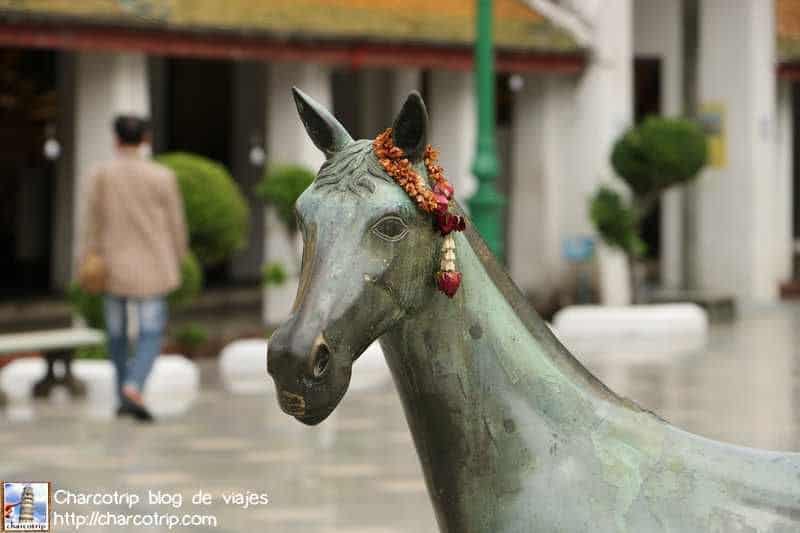

We got into a huge room with a huge Buddha, that’s where they charged us for admission, we stayed for quite a while. It was a privilege to be able to be there so peacefully since there was hardly anyone and at certain times we were left alone.
In addition to the imposing Buddha, about 8 meters high, several statues could be seen in what seemed to be his disciples. It caught my attention that there were literally all colors.
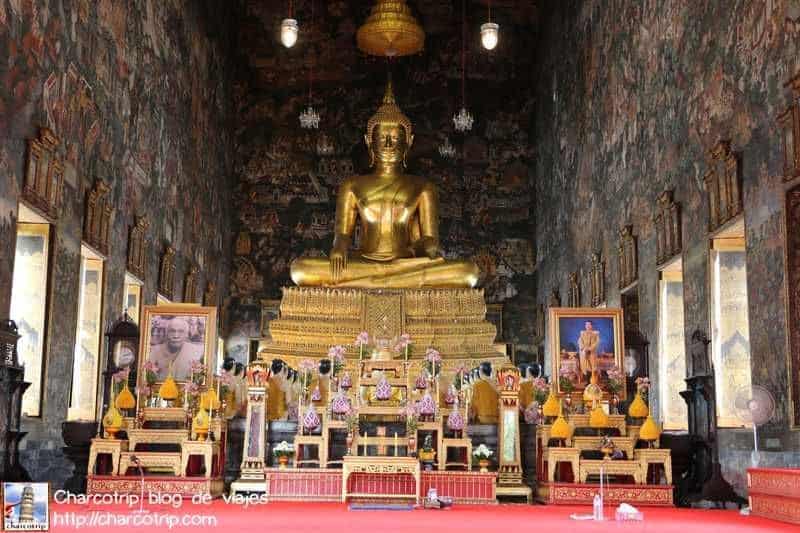


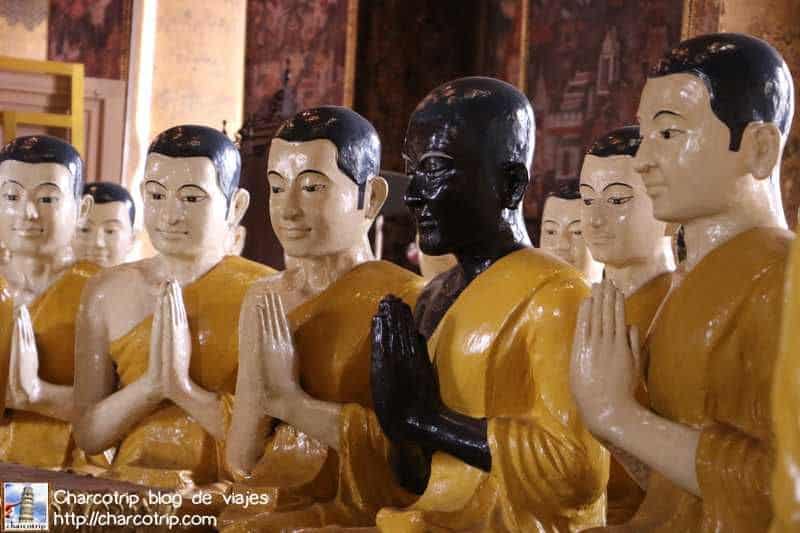

This last visit gave me back the idea that I had that Buddhist temples were a place of peace and tranquility. And it is that after seeing the first three I was already beginning to doubt it, but of course, they were the most popular in the city. And this is not to imply that Wat Suthat is unpopular, on the contrary its unique swing is what makes people come to see it (like me).
We would see more Buddhist temples in Thailand, but in Bangkok, it was only these, the temples that we would see next… they are temples… of consumption! That will come in a future article.
Some of the links in this article include affiliate links. This means that if you buy a product listed here by following these links, we'll receive a commission. The use of this link does not increase the final price for you and thus helps us to keep our blog alive.



